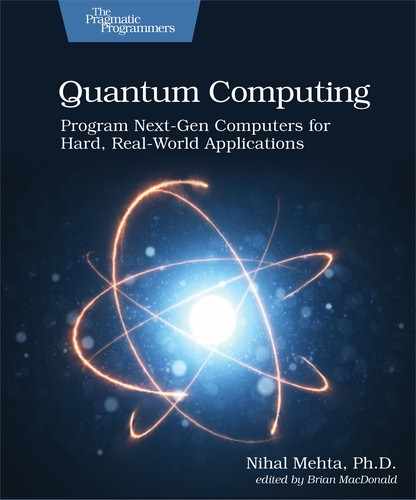Single Qubit Programs Solutions
Quantum Gates as Matrices Solutions
Solutions for the exercises in Try Your Hand.
-
The amplitude
 .
Thus, the probability of the qubit collapsing
to 0 is
.
Thus, the probability of the qubit collapsing
to 0 is
 .
.
The amplitude
 .
So the probability of the qubit collapsing
to 1 is
.
So the probability of the qubit collapsing
to 1 is

The sum of these probabilities is
 .
Since the sum is less than 1,
the vector doesn’t represent a valid
quantum state.
.
Since the sum is less than 1,
the vector doesn’t represent a valid
quantum state.
-
The amplitude
 .
Thus, the probability of the qubit collapsing
to 0 is
.
Thus, the probability of the qubit collapsing
to 0 is
 .
.
The amplitude
 .
So the probability of the qubit collapsing
to 1 is
.
So the probability of the qubit collapsing
to 1 is

The sum of these probabilities is
 .
Since the sum is, for all intents and
purposes, 1,
the vector represents a valid
quantum state.
.
Since the sum is, for all intents and
purposes, 1,
the vector represents a valid
quantum state.
-
-
The qubelets before and after the Z gate are shown here:

The Z gate inverts only the triangle
 qubelet.
qubelet.
-
The left qubelet only has a triangle
 qubelet. Thus,
qubelet. Thus,  .
And the quantum state of the qubit
before the Z gate acts on it is:
.
And the quantum state of the qubit
before the Z gate acts on it is:

After the Z gate acts on the qubit, the triangle
 qubelet is inverted. So
qubelet is inverted. So  .
And the quantum state after the Z gate
acts on it is:
.
And the quantum state after the Z gate
acts on it is:

-
-
The qubelets before and after the H gate acts on the qubit is shown in the following figure:

The H gate splits the triangle
 qubelet into
a pentagon
qubelet into
a pentagon  qubelet
and an inverted triangle
qubelet
and an inverted triangle  qubelet.
qubelet.
-
The left qubelet only has a triangle
 qubelet. Thus,
qubelet. Thus,  .
And the quantum state of the qubit
before the H gate acts on it is:
.
And the quantum state of the qubit
before the H gate acts on it is:

After the H gate acts on the qubit, the triangle
 qubelet is split into a pentagon
qubelet is split into a pentagon  qubelet and an inverted triangle
qubelet and an inverted triangle  qubelet. The amplitudes are:
qubelet. The amplitudes are:

Wrting the amplitudes in vector form, we get:

-
-
The operation is:

-
The first column of the
 matrix is:
matrix is:

-
-
The operation is:

-
The complete
 matrix is:
matrix is:

-
-
This qubit has two pentagon
 qubelets and one inverted triangle
qubelets and one inverted triangle  qubelet. Thus, its normalized quantum state is:
qubelet. Thus, its normalized quantum state is:

The negative sign for the amplitude associated with
 indicates that the
triangle qubelet is inverted.
indicates that the
triangle qubelet is inverted.
The vector for this quantum state is:

The probabilities of the qubit collapsing to 0 and 1 are:

-
When the NOT gate acts on the qubit with two pentagon
 qubelets and an inverted triangle
qubelets and an inverted triangle  qubelet, it switches the two pentagon
qubelet, it switches the two pentagon  qubelets
to two triangle
qubelets
to two triangle  qubelets,
and it switches the inverted triangle
qubelets,
and it switches the inverted triangle  qubelet to an inverted pentagon
qubelet to an inverted pentagon  qubelet,
as shown in the following figure:
qubelet,
as shown in the following figure:

The normalized quantum state of the blended qubit on the right is:

(Note the inverted pentagon
 qubelet drawn on the right of the right qubit.
This placement reflects that the NOT
gate switched the inverted triangle
qubelet drawn on the right of the right qubit.
This placement reflects that the NOT
gate switched the inverted triangle  qubelet in the left qubit.)
qubelet in the left qubit.)
Writing this quantum state in vector form, we get:

The probabilities of the qubit collapsing to 0 and 1 are:

The probabilities of the qubit collapsing to 0 and 1, respectively, get switched after the NOT gate acts on the qubit. In other words, when a NOT gate acts on a blended qubit, the probabilities of collapsing to the classical states 0 or 1 are switched.
-
To calculate the quantum state of the qubit after the NOT gate acts on it, multiply the
 matrix by the vector for the initial
quantum state as follows:
matrix by the vector for the initial
quantum state as follows:

This quantum state is identical to the one obtained by analyzing the NOT gate operation using qubelets.
-
-
The operation is:

-
The first column of the
 matrix is:
matrix is:

-
-
The operation is:

-
The complete
 matrix is:
matrix is:

-
-
This qubit has one pentagon
 qubelet and two inverted triangle
qubelet and two inverted triangle  qubelets. Thus, it’s normalized quantum state is:
qubelets. Thus, it’s normalized quantum state is:

The negative size for the amplitude associated with
 indicates that the triangle qubelet is inverted.
indicates that the triangle qubelet is inverted.
The vector for this quantum state is:

-
When the Z gate acts on the qubit with one pentagon
 qubelet and two inverted triangle
qubelet and two inverted triangle  qubelets, it’ll leave the pentagon qubelet alone but
will switch the triangle qubelets, as shown in the
following figure:
qubelets, it’ll leave the pentagon qubelet alone but
will switch the triangle qubelets, as shown in the
following figure:

The normalized quantum state of the blended qubit on the right is:

Writing this quantum state in vector form, we get:

-
To calculate the quantum state of the qubit after the Z gate acts on it, multiply the
 matrix by the vector for the initial
quantum state, as follows:
matrix by the vector for the initial
quantum state, as follows:

This quantum state is identical to the one obtained by analyzing the Z gate operation using qubelets.
-
Gate Matrix Restrictions Solutions
Solutions for the exercises in Try Your Hand.
-
To determine the Hermitian matrix, first get its transpose,
 , by switching
the matrix’s rows and columns:
, by switching
the matrix’s rows and columns:

Next, replace each element with its complex conjugate:

-
To check if this matrix represents a quantum gate, first calculate the product matrix,
 :
:

To multiply these matrices, we’ll use the method described in Multiplying Matrices. According to this method, we’ll get the product matrix by working out each column of the product individually. The first column of the product matrix is:

The second column of the product is:

Arrange these columns to get the product:

Since the product
 isn’t
the identity matrix,
isn’t
the identity matrix,
 isn’t a valid quantum
gate matrix.
isn’t a valid quantum
gate matrix.
-
-
To determine the Hermitian matrix, first get its transpose,
 ,
by switching the matrix’s rows and columns:
,
by switching the matrix’s rows and columns:

Next, replace each element with its complex conjugate:

This matrix for the
 gate
is identical to the
gate
is identical to the  matrix for the
matrix for the  gate.
gate.
-
To see if this matrix represents a quantum gate, first calculate the product matrix,
 :
:

To multiply these matrices, we’ll use the method described in Multiplying Matrices. According to this method, we’ll get the product matrix by working out each column of the product individually. The first column of the product matrix is:

The second column of the product matrix is:

Arrange these columns to get the product:

Since the product is the identity matrix, it represents a quantum gate. In fact, the
 gate is one of the
predefined gates in the IBM Quantum Computer.
gate is one of the
predefined gates in the IBM Quantum Computer.
-
-
To determine the Hermitian matrix, first get its transpose,
 , by
switching the matrix’s rows and columns:
, by
switching the matrix’s rows and columns:
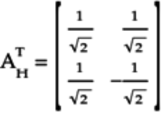
Since each element of the matrix is real, this matrix is the conjugate transpose. In other words,

-
To see if this matrix represents a quantum gate, first calculate the product matrix
 :
:

To multiply these matrices, we’ll use the method described in Multiplying Matrices. According to this method, we’ll get the product matrix by working out each column of the product individually. The first column of the product matrix is:

The second column of the product matrix is:

Arrange these columns to get the product:

Since this product is the identity matrix, the
 matrix represents
the H gate.
matrix represents
the H gate.
-
-
To get the
 matrix for
matrix for
 ,
set
,
set  ,
,  , and
, and
 :
:

Noting that
 ,
,
 , the
above matrix simplifies to:
, the
above matrix simplifies to:
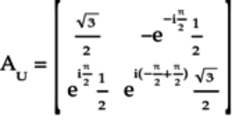
Using Euler’s formula:

And,

Substituting these terms back in the matrix
 :
:

-
To determine the Hermitian matrix, first get its transpose:

Next, replace each element of the matrix with its conjugate:

-
To check if the
 matrix is
unitary, first calculate the product matrix
matrix is
unitary, first calculate the product matrix
 :
:
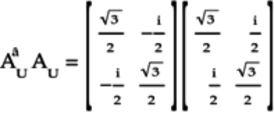
To multiply these matrices, we’ll use the method described in Multiplying Matrices. According to this method, we’ll get the product matrix by working out each column of the product individually. The first column of the product matrix is:

The second column of the product matrix is:

Arrange these columns to get the product:

Since the product is the identity matrix, matrix
 is unitary.
is unitary.
-
To determine the parameters for the Universal gate,
 , associated with
, associated with
 , equate the
, equate the
 matrix with that of
matrix with that of
 :
:

The idea in these types of matrix equations is to compare the respective elements in the matrix on the left to the one on the right. Start with the element on the right that has the fewest parameters. Thus, looking at the top left element from both matrices:

Next, equate the bottom left (second row, first column) elements in both matrices:

Since the imaginary part on the right is
 ,
the imaginary part on the left,
,
the imaginary part on the left,  ,
must also be
,
must also be  . The smallest such
angle is 270° or:
. The smallest such
angle is 270° or:

This value also makes the real part,
 .
.
Finally, to compute
 ,
compare the top right (first row, second column)
terms from both matrices:
,
compare the top right (first row, second column)
terms from both matrices:
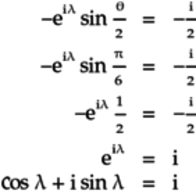
Since the real part on the right is 0, the real part on the left,
 ,
is also 0:
,
is also 0:

A quick check confirms that this value of
 makes the imaginary part on the right,
makes the imaginary part on the right,
 ,
equal to 1 as required.
,
equal to 1 as required.
Note that we only needed three of the four element comparisons to get the three parameters for the
 gate. You can verify,
though, that these three values correctly equate to the
fourth element on the bottom right of the right matrix
stated earlier.
gate. You can verify,
though, that these three values correctly equate to the
fourth element on the bottom right of the right matrix
stated earlier.
The Universal gate that implements the
 matrix is
matrix is
 .
.
-
To compute the quantum state when the
 gate acts on the
gate acts on the  qubit, calculate the following:
qubit, calculate the following:
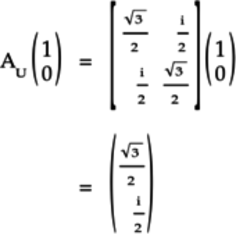
Or, writing the quantum state as an equation:

-
To compute the probabilities of the qubit collapsing to the idealized states, take the squares of the amplitudes but use the conjugate complexes, as explained in Measuring Magnitudes of Complex Numbers:

And,

-
The quantum program is listed here:
qreg q[1]; creg c[1]; u3(pi/3,pi/2,-pi/2) q[0]; measure q[0] -> c[0]; -
The output of this program is shown in the following figure:

Yes, the likelihoods of finding 0 or 1 in the classical registers is roughly 75% or 25%, respectively. These match the probabilities of the q[0] qubit collapsing to
 or
or  , respectively,
as calculated earlier.
, respectively,
as calculated earlier.
-
-
The quantum program for the circuit with back-to-back Universal gates is listed here:
1: qreg q[1]; 2: creg c[1]; 3: 4: u3(pi/3,pi/2,-pi/2) q[0]; 5: u3(pi/3,3*pi/2,pi/2) q[0]; 6: measure q[0] -> c[0]; The
 gate is
declared on line 5.
gate is
declared on line 5.
-
The output of this program is shown in the following figure:

The
 gate
restores the quantum state of the q[0] back to
gate
restores the quantum state of the q[0] back to
 . In other words, since this gate
is the Hermitian matrix of the
. In other words, since this gate
is the Hermitian matrix of the  gate, it reverses the action on the
qubit and puts it back to the original state before
these gates acted on it.
Thus, the concept of back-to-back gates defined by matrices that are
Hermitians of each other is similar to what you saw
earlier in
Back-to-Back H Gates: The First Hint of Taming Randomness.
gate, it reverses the action on the
qubit and puts it back to the original state before
these gates acted on it.
Thus, the concept of back-to-back gates defined by matrices that are
Hermitians of each other is similar to what you saw
earlier in
Back-to-Back H Gates: The First Hint of Taming Randomness.
-
-
The quantum program for this circuit is as follows:
qreg q[1]; creg c[1]; u3(pi/3,pi/2,-pi/2) q[0]; u3(pi/3,pi/4,-pi/2) q[0]; measure q[0] -> c[0]; -
The output of this program is shown here:

In this case, the q[0] qubit isn’t restored to its original
 state as in the previous part. Both U3 gates
have the same
state as in the previous part. Both U3 gates
have the same  , which determines the
numbers of pentagon
, which determines the
numbers of pentagon  and triangle
and triangle
 qubelets in the quantum state,
and the same
qubelets in the quantum state,
and the same  .
But they have different values for the
second parameter,
.
But they have different values for the
second parameter,  , which measures
the relative difference between the orientations
of the pentagon
, which measures
the relative difference between the orientations
of the pentagon  and triangle
and triangle
 qubelets.
Because the second U3 gate’s
qubelets.
Because the second U3 gate’s
 angle doesn’t exactly “twist back”
the effect of the first gate on the qubelets, the
quantum state isn’t restored. Hence, the qubit doesn’t
go back to
angle doesn’t exactly “twist back”
the effect of the first gate on the qubelets, the
quantum state isn’t restored. Hence, the qubit doesn’t
go back to  after the second
U3 gate and remains in a
blended state. When this blended
qubit is measured, it collapses to either
after the second
U3 gate and remains in a
blended state. When this blended
qubit is measured, it collapses to either  or
or  . As a result, the classical
register records both the 0 and 1 states.
. As a result, the classical
register records both the 0 and 1 states.
-
-
-
Let
 be the quantum state of the qubit
before it’s acted on by the
be the quantum state of the qubit
before it’s acted on by the  gate.
Then, the following matrix
equation defines how the
gate.
Then, the following matrix
equation defines how the  gates modifies this quantum state:
gates modifies this quantum state:

To get
 , pre-multiply both sides
by the
, pre-multiply both sides
by the  matrix’s Hermitian,
matrix’s Hermitian,
 :
:
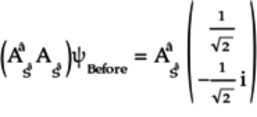
Note that
 . Thus,
. Thus,
 ,
the identity matrix.
As a result, the left-hand side simplifies to
,
the identity matrix.
As a result, the left-hand side simplifies to  .
After substituting
.
After substituting  for
for  on the right-hand side, the above equation reduces to:
on the right-hand side, the above equation reduces to:

Thus, the original quantum state before the
 gate operates on it is:
gate operates on it is:
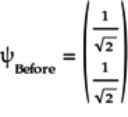
Analyzing Quantum Gate Matrices Solutions
Solutions for the exercises in Try Your Hand.
-
The equation for the given quantum state,
 , is:
, is:

Compare this equation with that of the general quantum state:

The
 term injects the
complex number into the equation for the
state. To determine the value of
term injects the
complex number into the equation for the
state. To determine the value of  ,
relate the corresponding
terms in the general equation with that of the
given quantum state
,
relate the corresponding
terms in the general equation with that of the
given quantum state  :
:

The real term,
 , must be
0 since the right-hand side is a pure complex number:
, must be
0 since the right-hand side is a pure complex number:

Further,
 confirms that the calculations for
confirms that the calculations for  are
right.
Thus, the angle
are
right.
Thus, the angle  , the relative difference
between the orientations of the pentagon
, the relative difference
between the orientations of the pentagon  and triangle
and triangle  qubelets, is
90°.
qubelets, is
90°.
To calculate
 , the angle which the
quantum state vector leans away from the vertical
on the Bloch sphere, compare the amplitudes for
, the angle which the
quantum state vector leans away from the vertical
on the Bloch sphere, compare the amplitudes for
 and
and  in the general equation for the quantum state with
that for
in the general equation for the quantum state with
that for  :
:

Calculate
 from the amplitude for
from the amplitude for
 as follows:
as follows:

Setting
 in the
amplitude for
in the
amplitude for  ,
,
 , gives
, gives  ,
validating that our calculations are correct.
,
validating that our calculations are correct.
Thus, the parameters for the
 gate are:
gate are:

Since we are working on
 ,
we only need to look at the first column of the
gate matrix for U3 which doesn’t rely on
,
we only need to look at the first column of the
gate matrix for U3 which doesn’t rely on
 . So, any value of
. So, any value of  can be used as it’ll not affect the behavior of the
gate on
can be used as it’ll not affect the behavior of the
gate on  .
.
Recall from Number of Qubelets Define the Amplitudes, the number of pentagon
 and triangle
and triangle  qubelets in the qubit
are related as follows:
qubelets in the qubit
are related as follows:

These parameters for the
 gate
puts the
gate
puts the  qubit in the
quantum state
qubit in the
quantum state  having an equal number
of pentagon
having an equal number
of pentagon  and triangle
and triangle
 qubelets, with the
triangle
qubelets, with the
triangle  qubelets rotated
90° anticlockwise, as shown in the following figure:
qubelets rotated
90° anticlockwise, as shown in the following figure:
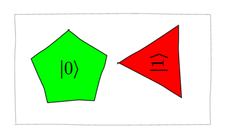
This quantum state is identical to the one worked out in the previous section using the qubelets approach.
The probabilities of the qubit collapsing to
 or
or  ,
respectively, is the “square” of the amplitudes:
,
respectively, is the “square” of the amplitudes:

Notice that to compute the probability of collapsing to
 , the amplitude
is a complex number, so we multiply by its
complex conjugate.
, the amplitude
is a complex number, so we multiply by its
complex conjugate.
-
The quantum circuit is shown here:

The quantum program is the following:
qreg q[1]; creg c[1]; u3(pi/2,pi/2,0) q[0]; measure q[0] -> c[0]; The output of this program is shown in the following figure:

The classical registers won’t log the angles of the pentagon
 and triangle
and triangle
 qubelets. But the classical
states recorded match the probabilities of the qubit
collapsing to
qubelets. But the classical
states recorded match the probabilities of the qubit
collapsing to  or
or
 , respectively, calculated
in the previous part.
, respectively, calculated
in the previous part.
-
The quantum program is as follows:
qreg q[1]; creg c[1]; u3(pi/2,pi/2,0) q[0]; s q[0]; measure q[0] -> c[0]; The output of this program is shown.

Since the S gate only rotates the pentagon
 qubelets but doesn’t split any
qubelets, the relative number of pentagon
qubelets but doesn’t split any
qubelets, the relative number of pentagon  and
and  qubelets remains the same.
Consequently, the probabilities of the qubit collapsing to
qubelets remains the same.
Consequently, the probabilities of the qubit collapsing to
 or
or  don’t change and, hence, the classical states recorded
in the classical registers will also be similar to what
was recorded in the previous part.
don’t change and, hence, the classical states recorded
in the classical registers will also be similar to what
was recorded in the previous part.
-
No, you can’t confirm whether the pentagon
 qubelets are rotated
since the gates didn’t change the relative number
of pentagon
qubelets are rotated
since the gates didn’t change the relative number
of pentagon  and
triangle
and
triangle  qubelets.
(In later sections you’ll learn to write programs
that validate the qubelet rotations.)
qubelets.
(In later sections you’ll learn to write programs
that validate the qubelet rotations.)
-
-
The vector for the general quantum state
 is:
is:
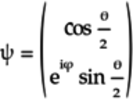
The
 parameter, which measures the
relative difference in orientations between the
pentagon
parameter, which measures the
relative difference in orientations between the
pentagon  and the
triangle
and the
triangle  qubelets,
is associated with the triangle
qubelets,
is associated with the triangle  qubelets. Thus, turning both qubelets
by the same angle doesn’t change the quantum state.
Redraw the qubit on the right so that
the pentagon
qubelets. Thus, turning both qubelets
by the same angle doesn’t change the quantum state.
Redraw the qubit on the right so that
the pentagon  qubelet is rotated back to the non-rotated state by
turning both qubelets 90° clockwise, as
shown in the following figure:
qubelet is rotated back to the non-rotated state by
turning both qubelets 90° clockwise, as
shown in the following figure:

The required gate leaves the pentagon
 qubelet alone. Thus,
the top left element of the gate’s matrix must be
1:
qubelet alone. Thus,
the top left element of the gate’s matrix must be
1:

The
 indicates that those corresponding
terms aren’t yet known.
indicates that those corresponding
terms aren’t yet known.
This gate doesn’t take a qubelet of one type and change it to the other type by splitting or switching the qubelet. As a result, the non-diagonal terms in the gate’s matrix are 0:

(If the gate were to split qubelets, for example, then the non-diagonal terms would be nonzero.)
The triangle
 qubelet is rotated 90° clockwise.
This rotation is governed by the following
equation:
qubelet is rotated 90° clockwise.
This rotation is governed by the following
equation:

Substitute
 for
for  (the sign is negative because the rotation is
clockwise):
(the sign is negative because the rotation is
clockwise):

Thus, the gate matrix is:

Since this matrix must be Hermitian for a quantum gate, you can confirm that something is 1. Hence, this matrix matches that of the
 gate.
gate.
Although this problem is ostensibly about rotating a pentagon
 qubelet, it’s actually equivalent to rotating the
triangle
qubelet, it’s actually equivalent to rotating the
triangle  qubelet.
qubelet.
Solutions: Quantum Gates and How to Use Them
Solutions for the exercises in Try Your Hand.
-
False. The Y gate switches and rotates qubelets. That is, when it acts on, say, a triangle
 qubelet, it’ll switch it to a pentagon
qubelet, it’ll switch it to a pentagon
 qubelet and
rotate it. But it won’t split qubelets.
Hence, it doesn’t take an idealized quantum
state and put it in a blended
state.
qubelet and
rotate it. But it won’t split qubelets.
Hence, it doesn’t take an idealized quantum
state and put it in a blended
state.
-
False. Both the
 and
T gates leave the
and
T gates leave the  qubelets alone but rotate the triangle
qubelets alone but rotate the triangle  qubelets. So they’ll have no effect on the
qubelets. So they’ll have no effect on the  qubit but will rotate the triangle
qubit but will rotate the triangle  qubelets in the
qubelets in the  qubit.
qubit.
-
True. The S gate rotates the triangle
 qubelets
90°, or a quarter turn anticlockwise.
The
qubelets
90°, or a quarter turn anticlockwise.
The  gate rotates the
triangle
gate rotates the
triangle  qubelets
45°, or a
one-eighth
turn clockwise. Both leave the
pentagon
qubelets
45°, or a
one-eighth
turn clockwise. Both leave the
pentagon  qubelets
alone. Thus, two
qubelets
alone. Thus, two  gates
rotate the triangle
gates
rotate the triangle  qubelets by 90°, or a quarter turn
clockwise, reversing the action of the
S gate.
qubelets by 90°, or a quarter turn
clockwise, reversing the action of the
S gate.
-
True. The S gate rotates the triangle
 qubelets
90°, or a quarter turn anticlockwise.
The T gate rotates the triangle
qubelets
90°, or a quarter turn anticlockwise.
The T gate rotates the triangle
 qubelets by
45°, or a one-eighth
turn anticlockwise. Thus, when both gates operate on the
triangle
qubelets by
45°, or a one-eighth
turn anticlockwise. Thus, when both gates operate on the
triangle  qubelets,
the total rotation is
qubelets,
the total rotation is  °
anticlockwise.
°
anticlockwise.
-
True. The
 gate splits
qubelets like the H gate, although
asymmetrically. Nonetheless, it puts an idealized
qubit,
gate splits
qubelets like the H gate, although
asymmetrically. Nonetheless, it puts an idealized
qubit,  or
or  ,
into a blended state.
,
into a blended state.
-
-
The quantum state after the Y gate acts on the
 qubit is
shown in the following figure:
qubit is
shown in the following figure:

-
If the NOT (X) gate were to act on the
 qubit,
the pentagon
qubit,
the pentagon  qubit
would be switched to a triangle
qubit
would be switched to a triangle  qubit but wouldn’t be rotated, as shown in the next figure:
qubit but wouldn’t be rotated, as shown in the next figure:

-
Regardless of how the triangle
 qubelet is rotated, it’ll always collapse to the
idealized
qubelet is rotated, it’ll always collapse to the
idealized  qubit, which
logs a 1 in the classical register.
Thus, in both cases, the outputs will be
identical.
qubit, which
logs a 1 in the classical register.
Thus, in both cases, the outputs will be
identical.
-
-
As each gate acts on the
 qubit, it affects the qubelets as follows:
qubit, it affects the qubelets as follows:
- First X Gate
-
Switches the
 qubit
to
qubit
to  . The
qubit will contain only a triangle
. The
qubit will contain only a triangle
 qubelet.
qubelet.
- T Gate
-
Rotates the triangle
 qubelet by 45°, or a one-eighth
turn anticlockwise.
qubelet by 45°, or a one-eighth
turn anticlockwise.
- Second X Gate
-
Switches the
 qubit to
qubit to
 . The 45°-rotated triangle
. The 45°-rotated triangle  qubelet is switched to a 45°-rotated
pentagon
qubelet is switched to a 45°-rotated
pentagon  qubelet.
qubelet.
The action of these three gates is summarized in the following figure:

Thus, this circuit rotates the pentagon
 qubelet.
qubelet.
-
The program for this circuit is as follows:
qreg q[1]; creg c[1]; h q[0]; sdg q[0]; h q[0]; measure q[0] -> c[0]; -
The output of this program is shown in the following figure:

The output shows a 0 or 1 logged in the classical register with about the same probabilities. This distribution indicates that the q[0] qubit collapses about equally to the idealized qubits,
 or
or  . This suggests
that the q[0] qubit was in a
blended state before it was
collapsed by the Measure gate.
Had the second H gate reversed
the effect of the first H gate,
the q[0] qubit would be put back to
. This suggests
that the q[0] qubit was in a
blended state before it was
collapsed by the Measure gate.
Had the second H gate reversed
the effect of the first H gate,
the q[0] qubit would be put back to
 .
.
The reason why the second H gate, despite being its own adjoint, doesn’t reverse the effect of the first H gate on the qubit is that the
 gate spins the triangle
gate spins the triangle  qubelets by –90°, or a quarter turn clockwise.
As a direct result of this extra rotation, the
triangle
qubelets by –90°, or a quarter turn clockwise.
As a direct result of this extra rotation, the
triangle  qubelets are
no longer aligned with the pentagon
qubelets are
no longer aligned with the pentagon  qubelets, as shown in the following figure:
qubelets, as shown in the following figure:

When the right qubit gets split by the second H gate, the triangle
 qubelets can’t cancel out, thereby leaving the qubit in a
blended state, as shown in the next figure:
qubelets can’t cancel out, thereby leaving the qubit in a
blended state, as shown in the next figure:

This is the first time you’re seeing a quantum state where the qubelets of the same type have different angles. In the next section, you’ll learn how to deal with such quantum states. For now, it’s enough to recognize that the triangle
 qubelets can’t cancel out to give an idealized state.
Thus, the qubit remains in a blended state.
qubelets can’t cancel out to give an idealized state.
Thus, the qubit remains in a blended state.
-
The quantum program for this circuit is listed as follows:
qreg q[1]; creg c[1]; h q[0]; sdg q[0]; » s q[0]; h q[0]; measure q[0] -> c[0]; This program is the same as that in the previous part other than declaring the S gate as highlighted.
You should get an output for this program that is similar to the one shown.
This time, the classical register only logs 0, indicating that the second H gate successfully put the q[0] qubit in its original idealized state,
 . The reason
for this is that the S gate
spun the triangle
. The reason
for this is that the S gate
spun the triangle  qubelets back by 90°, or a quarter
turn anticlockwise, and aligned them. As a
result, the second H gate
could cancel out the triangle
qubelets back by 90°, or a quarter
turn anticlockwise, and aligned them. As a
result, the second H gate
could cancel out the triangle  qubelets from the quantum state.
qubelets from the quantum state.

-
-
The code listing for this circuit is as follows:
qreg q[1]; creg c[1]; rx(pi/3) q[0]; measure q[0] -> c[0]; -
The vector for the
 qubit in q[0] is:
qubit in q[0] is:

Thus, the quantum state
 after the
after the  acts on the
acts on the
 qubit is:
qubit is:

-
The vector for
 is:
is:
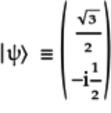
Thus, the ratio of pentagon
 to triangle
to triangle  qubelets is
qubelets is
 .
.
-
To get the angles of rotation of the qubelets, compare the vector for
 with that
for the general quantum state.
Thus, the pentagon
with that
for the general quantum state.
Thus, the pentagon  qubelets
aren’t rotated, but the triangle
qubelets
aren’t rotated, but the triangle  qubelets are rotated by --90°, or a quarter
turn clockwise.
qubelets are rotated by --90°, or a quarter
turn clockwise.
-
Probability of
 collapsing to the idealized states is the
squares of their respective amplitudes.
Thus, the probability of
collapsing to the idealized states is the
squares of their respective amplitudes.
Thus, the probability of  collapsing to
collapsing to  is:
is:

Similarly, the probability of
 collapsing to
collapsing to  is:
is:

Because the amplitude for
 is a complex number, we multiply it by its
complex conjugate instead of directly squaring
it.
is a complex number, we multiply it by its
complex conjugate instead of directly squaring
it.
-
The output of running this program should be similar to the following figure:

The probabilities of recording the 0 and 1 bits in the classical register, about 75% and 25%, respectively, match those calculated in the previous part.
-
Sequence of Gates as Matrix Multiplication Solutions
Solutions for the exercises in Try Your Hand.
-
No. The correct way to multiply the gate matrices is:

The gate matrices are written in the reverse direction from the order in which the gates act on the qubit.
-
Yes. The
 gate reverses the
action of the T gate so, in effect,
the qubit isn’t affected by those gates.
In terms of matrices, the
gate reverses the
action of the T gate so, in effect,
the qubit isn’t affected by those gates.
In terms of matrices, the  state is calculated as follows:
state is calculated as follows:

Note that
 is the Hermitian
of
is the Hermitian
of  . So,
. So,  , resulting
in the simplification of the previous equation.
, resulting
in the simplification of the previous equation.
-
Yes. The Hermitian of the
 matrix,
matrix,  , is
just
, is
just  . So the given matrix multiplication
works out as follows:
. So the given matrix multiplication
works out as follows:

This equation represents the circuit in which the H gate first acts on the
 qubit followed by the S gate, as
shown in the figure for this part.
qubit followed by the S gate, as
shown in the figure for this part.
-
Yes. The S gate rotates the triangle
 qubelets
by a quarter turn anticlockwise. The
qubelets
by a quarter turn anticlockwise. The
 gate then rotates the
triangle
gate then rotates the
triangle  qubelets
a one-eighth
turn clockwise. Thus, the net rotation of the triangle
qubelets
a one-eighth
turn clockwise. Thus, the net rotation of the triangle
 qubelets is a
one-eighth turn
anticlockwise. This rotation corresponds to just
applying the T gate in place of the
S and
qubelets is a
one-eighth turn
anticlockwise. This rotation corresponds to just
applying the T gate in place of the
S and  gates.
gates.
We can also show this mathematically in terms of matrices. Start with the following equation, which directly uses the gate matrices as the gates appear in the circuit but in the reverse order:

Next, recognize that the
 matrix
is the square root of the
matrix
is the square root of the
 matrix. Thus, replace
matrix. Thus, replace  with
with  in the previous equation:
in the previous equation:

The last equation was simplified by noticing that
 .
.
-
Yes. The matrix multiplications for this sequence of gates to compute the final state
 is:
is:

Writing out the actual gate matrices for the H and Z gates, the previous equation becomes:
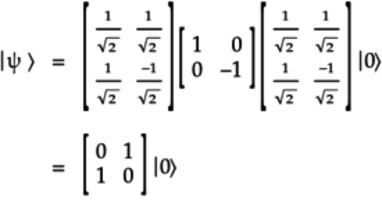
The matrix in the previous equation corresponds to the NOT (X) gate. Thus, the final quantum state can be written as:

-
-
No. This circuit won’t return anything since the qubit isn’t collapsed.
To get this circuit to run on a quantum computer, add a classical register and a Measure gate, as shown in the following figure:

-
The quantum program for the circuit in the previous part is listed here:
qreg q[1]; creg c[1]; h q[0]; sdg q[0]; rx(pi/6) q[0]; t q[0]; rx(pi/2) q[0]; measure q[0] -> c[0]; -
The probabilities of the qubit collapsing to the idealized states are calculated by multiplying the respective amplitudes by their conjugate complexes as follows:

And,

As an additional check, these probabilities add up to 1, indicating that the qubit collapses to either one of these two idealized states.
-
The output of running this program should be similar to the following figure:

The probabilities of recording 0 and 1 bits in the classical register, about 23% and 76%, respectively, match those calculated in the previous part.
-
-
The quantum state
 is:
is:

-
The quantum state vector in the Visualizations tab is identical to what’s calculated in the previous part.
-
The probabilities of the qubit collapsing to the idealized states are calculated by multiplying the respective amplitudes by their complex conjugates as follows:

And,

-
The code listing for this circuit is the following:
qreg q[1]; creg c[1]; h q[0]; s q[0]; h q[0]; measure q[0] -> c[0]; -
The output of running this program should be similar to the following figure:

The probabilities of recording 0 and 1 bits in the classical register, each about 50%, match those calculated in earlier.
-
